Best 11 FlutterFlow Alternatives for App Development (2025)
8 min
read
Explore the top 11 FlutterFlow alternatives in 2025 to build powerful apps faster, with no-code or low-code tools that match your needs.

Why Look for Alternatives to FlutterFlow?
FlutterFlow has earned its reputation as a powerful low-code platform for mobile app development, but it's not always the perfect fit for every project. Understanding when to explore alternatives can save you time, money, and frustration down the line. Let’s explore the key scenarios where choosing a different platform could be a smarter move:
- Web development isn't FlutterFlow's strong suit: While the platform excels at native mobile apps, its web capabilities feel like an afterthought. If you need a robust web application or want to prioritize web-first development, you'll quickly bump into limitations that make other platforms more suitable.
- The learning curve can be steeper than expected: Despite being a visual platform, FlutterFlow requires understanding Flutter concepts and mobile development principles. New users often find themselves overwhelmed by the complexity, especially when trying to implement custom functionality or navigate the interface effectively.
- Pricing becomes expensive as you scale: Starting at $30 per month for basic features, costs can escalate quickly when you need advanced capabilities, multiple team members, or higher usage limits. For startups and small businesses, this pricing structure can become prohibitive as projects grow.
- Limited customization without code knowledge: While FlutterFlow offers visual development, achieving truly custom designs or complex functionality often requires diving into Flutter code. This defeats the purpose for users seeking a pure no-code solution and can create barriers for non-technical teams.
- Database and backend limitations: The platform works best with Firebase, Supabase, or Xano, but integrating with other databases or building complex backend logic can be challenging. This restricts your architecture choices and may not align with your existing tech stack or business requirements.
Partner with LowCode Agency to Build Native Mobile Apps
At LowCode Agency, we specialize in transforming your app ideas into reality using the most powerful no-code and low-code platforms available. We're not just another development agency; we're your strategic partners in bringing innovative solutions to life quickly and cost-effectively.
With over 330 successfully delivered projects across industries ranging from real estate and construction to healthcare and education, we've mastered the art of choosing the right platform for each unique project.
Whether you need a FlutterFlow native mobile app, a Bubble web application, or a Glide business tool, our team knows exactly which technology will deliver the best results for your specific requirements.
Read more | FlutterFlow App Examples
What to Look for in a FlutterFlow Alternative
Choosing the right platform for your app development project requires careful consideration of several key factors. The best FlutterFlow alternative for your needs depends on your specific requirements, team capabilities, and long-term goals.
- Native app support should be a top priority if mobile performance matters: Look for platforms that can generate truly native iOS and Android apps, not just web apps wrapped in a mobile container. Native apps provide better performance, smoother animations, and access to device-specific features like camera, GPS, and push notifications that users expect from modern mobile experiences.
- Ease of use determines how quickly your team can become productive: Consider your team's technical expertise when evaluating platforms. Some alternatives offer simple drag-and-drop interfaces perfect for non-technical users, while others provide more advanced customization options that require some learning. The right balance depends on whether you prioritize speed of development or depth of customization.
- Code export options give you flexibility and peace of mind: Platforms that allow you to export your app's source code ensure you're not locked into a specific vendor forever. This feature becomes crucial if you need to migrate to custom development later or want to make modifications that the platform doesn't support natively.
- Backend integration capabilities determine what your app can actually do: Strong database connectivity, API integration options, and third-party service connections are essential for building functional apps. Look for platforms that seamlessly connect with popular services like Firebase, Airtable, or custom APIs, and consider whether the integration process aligns with your technical capabilities.
- Pricing structure should align with your budget and growth plans: Evaluate not just the upfront costs but also how pricing scales with users, features, and usage. Some platforms offer generous free tiers for prototyping, while others charge based on the number of app users or published apps. Consider your projected growth to avoid unexpected cost increases down the line.
- Scalability and flexibility ensure your platform can grow with your business: The best alternative should handle increased user loads, support complex workflows, and adapt to changing requirements without forcing you to rebuild from scratch. Look for platforms with robust infrastructure, regular feature updates, and the ability to handle enterprise-level demands if that's where you're headed.
Read more | FlutterFlow Pros and Cons
Top FlutterFlow Alternatives
Here are the leading alternatives to FlutterFlow, each with unique strengths that might better suit your specific project needs and development approach.
1. Bubble
Bubble stands out as a comprehensive full-stack web application builder that excels beyond simple app creation. Its visual programming approach allows you to build complex workflows without writing code, making it perfect for sophisticated business applications that require intricate logic and user interactions.
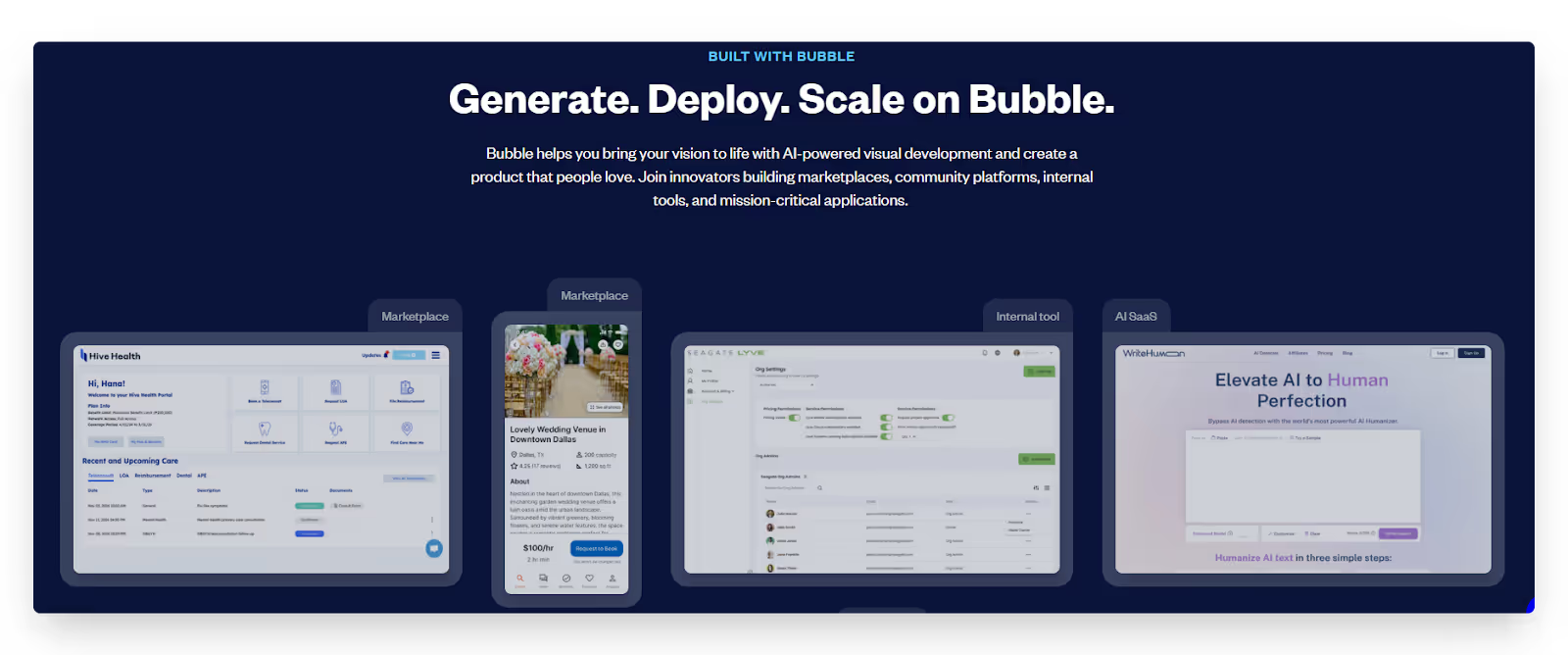
The platform's extensive plugin marketplace offers thousands of integrations and custom components, from payment processors like Stripe to advanced analytics tools. This ecosystem means you can add almost any functionality to your app without starting from scratch or waiting for platform updates.
Best for: Complex web applications, native mobile apps, SaaS platforms, marketplaces, and MVPs that need robust backend functionality. Bubble particularly shines when you need custom workflows, user authentication systems, and database-driven applications that go beyond simple mobile apps.
Read more | Bubble vs FlutterFlow
2.Glide
Glide transforms your existing data into beautiful, functional apps in minutes rather than months. Its seamless integration with Google Sheets, Airtable, and other data sources means you can launch apps incredibly quickly using information you already have organized.
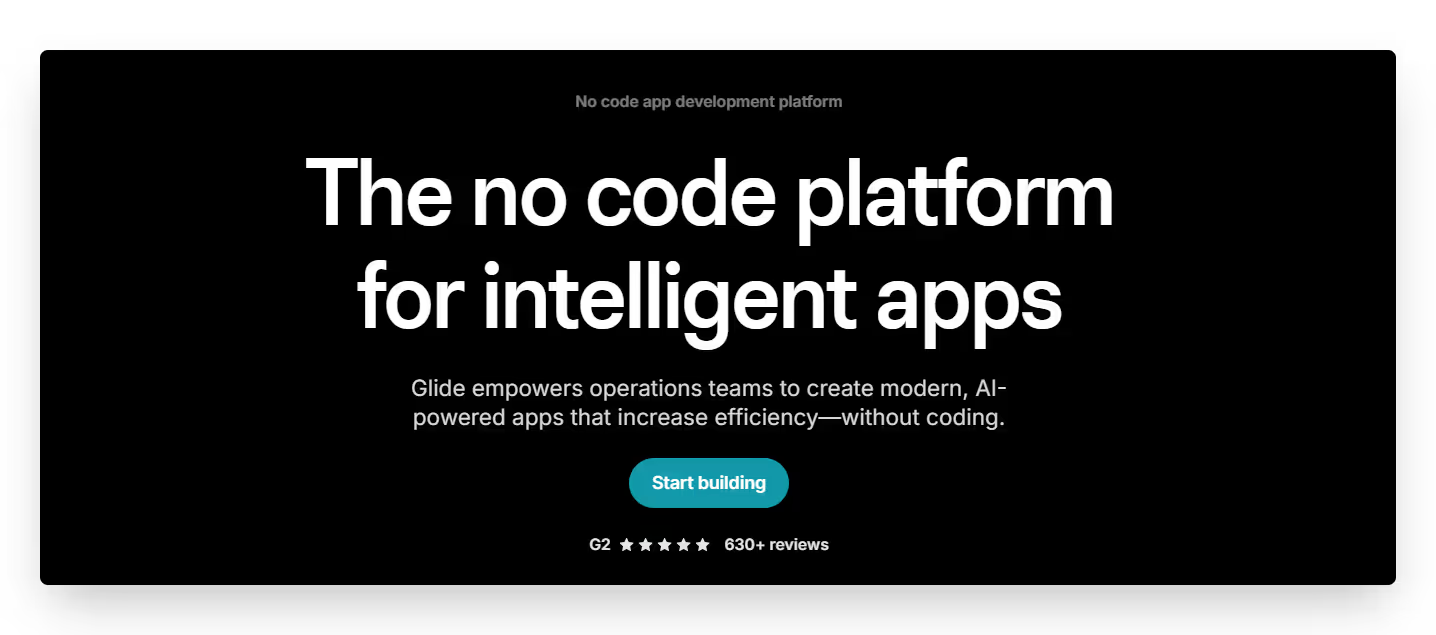
The platform's clean, intuitive interface makes app creation accessible to anyone, regardless of technical background. Glide automatically handles responsive design, ensuring your apps look professional on any device while maintaining fast loading times and smooth performance.
Best for: Business tools, internal apps, data visualization, and rapid prototyping. Glide excels when you need to quickly transform data into functional apps or create powerful tools for teams and small businesses.
Read more | FlutterFlow vs Glide
3. BuildFire
BuildFire provides a comprehensive suite of pre-built features specifically designed for mobile app development, including push notifications, social feeds, e-commerce capabilities, and user management systems. This feature-rich approach means you can launch sophisticated apps without building everything from scratch.
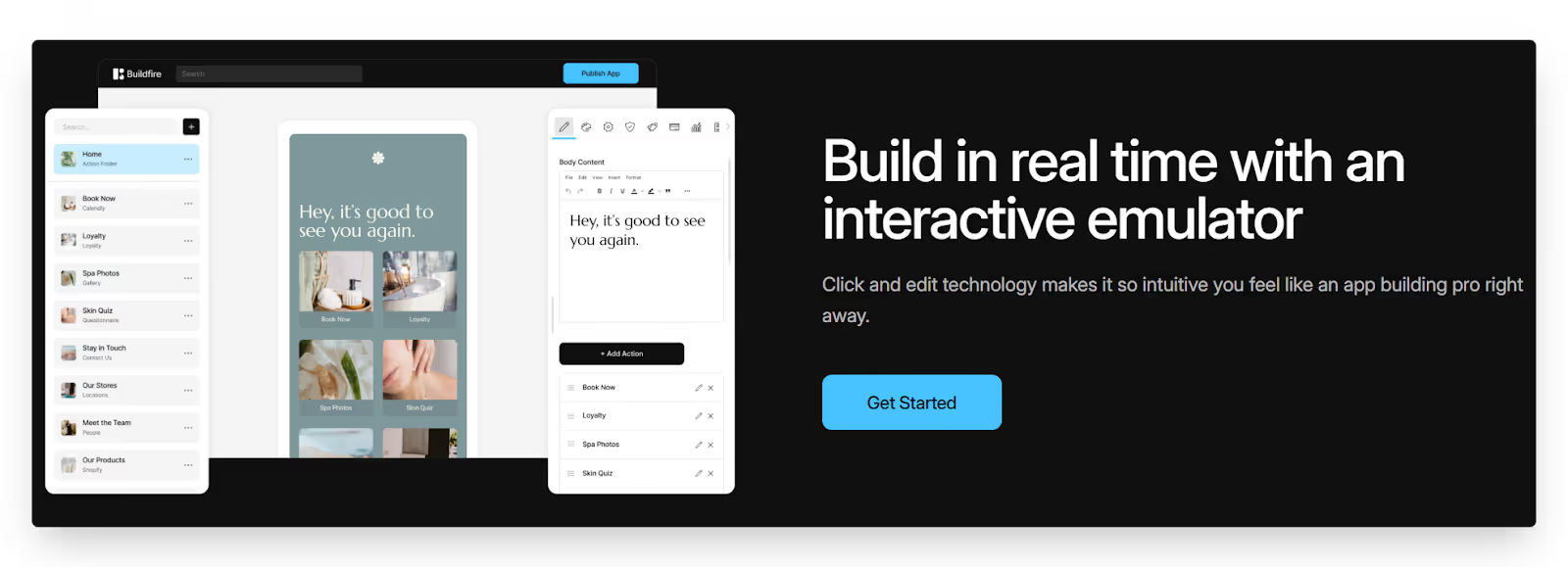
The platform's white-labeling options and direct app store deployment services make it particularly attractive for agencies and businesses that want to maintain their brand identity while leveraging proven functionality. BuildFire handles the complex technical aspects of app store submission and maintenance.
Best for: Mobile-first businesses, agencies serving multiple clients, and companies that need feature-rich apps with minimal development time. Particularly strong for apps requiring social features, content management, or e-commerce functionality.
Read more | FlutterFlow vs BuildFire
4. AppSheet
AppSheet leverages Google's infrastructure to turn Google Sheets into powerful mobile and web applications with built-in automation capabilities. The platform automatically generates app interfaces based on your data structure, then allows you to customize workflows and add business logic.
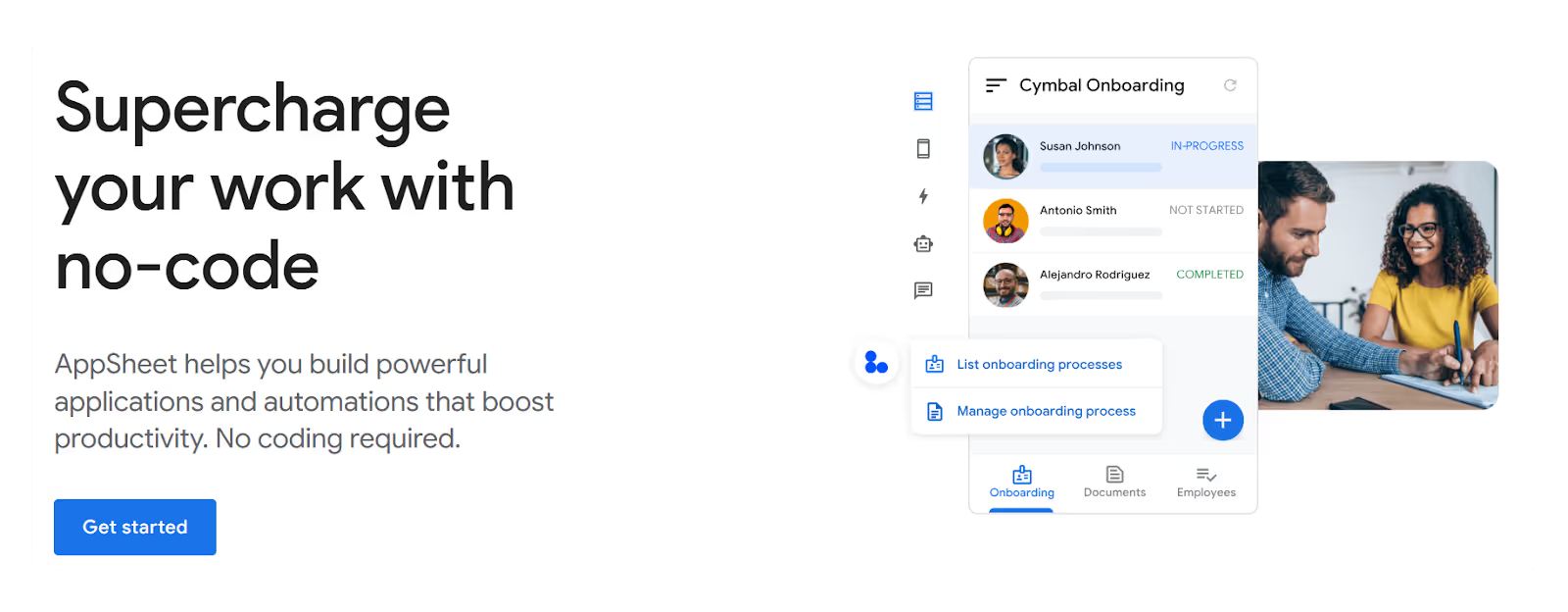
Advanced reporting and analytics features help you understand how your apps are being used and make data-driven decisions about improvements. The tight integration with Google Workspace makes it seamless for teams already using Google's productivity tools.
Best for: Google Workspace users, data-heavy applications, business process automation, and teams that need robust reporting capabilities. AppSheet is particularly powerful for field service apps, inventory management, and workflow automation tools.
Read more | FlutterFlow vs Appsheet
5. Bravo Studio
Bravo Studio bridges the gap between design and development by converting Figma designs directly into native mobile apps. This visual-first approach means designers can create pixel-perfect interfaces without losing fidelity during the development process.

The platform doesn't require complex backend setup for simple apps, making it ideal for content-driven applications or prototypes that need to look and feel exactly like the original design. This approach significantly reduces the time between design approval and functional app.
Best for: Design-heavy applications, agencies with strong design teams, content apps, and projects where visual accuracy is crucial. Perfect when you have detailed Figma designs and want to maintain complete design control.
Read more | FlutterFlow vs Bravo Studio
6. SAP Build Apps (Former AppGyver)
Sap Build Apps (former AppGyver) provides enterprise-grade visual development with sophisticated logic capabilities that can handle complex business requirements. The platform supports multi-platform deployment, allowing you to create web, mobile, and desktop applications from a single project.
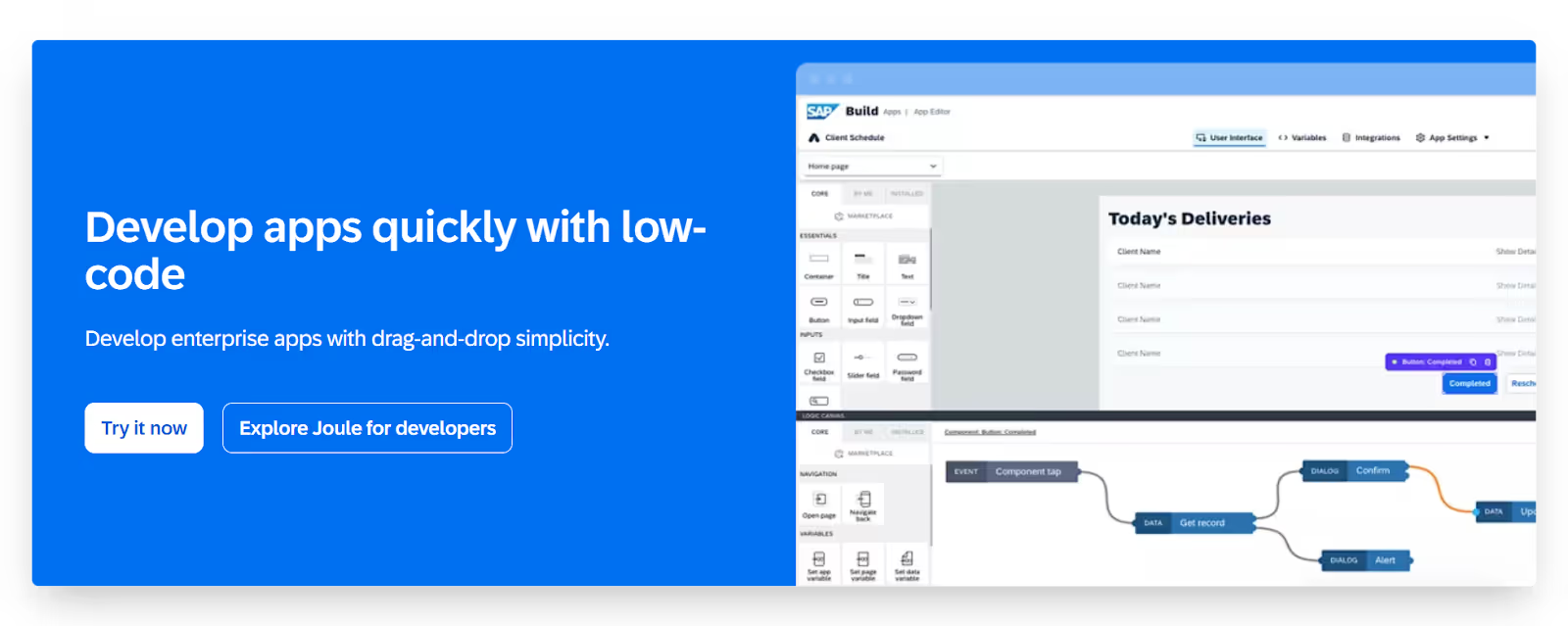
A strong community and comprehensive documentation make it easier to find solutions and get help when needed. The platform's professional approach makes it suitable for larger organizations that need robust, scalable applications.
Best for: Enterprise applications, complex business logic, multi-platform deployment, and teams that need professional support and community resources. Strong choice for organizations transitioning from traditional development to no-code solutions.
Read more | FlutterFlow vs AppGyver
7. Draftbit
Draftbit offers full React Native support with complete code export capabilities, giving you the flexibility to continue development outside the platform if needed. This approach provides the benefits of visual development while maintaining the option for custom coding when necessary.
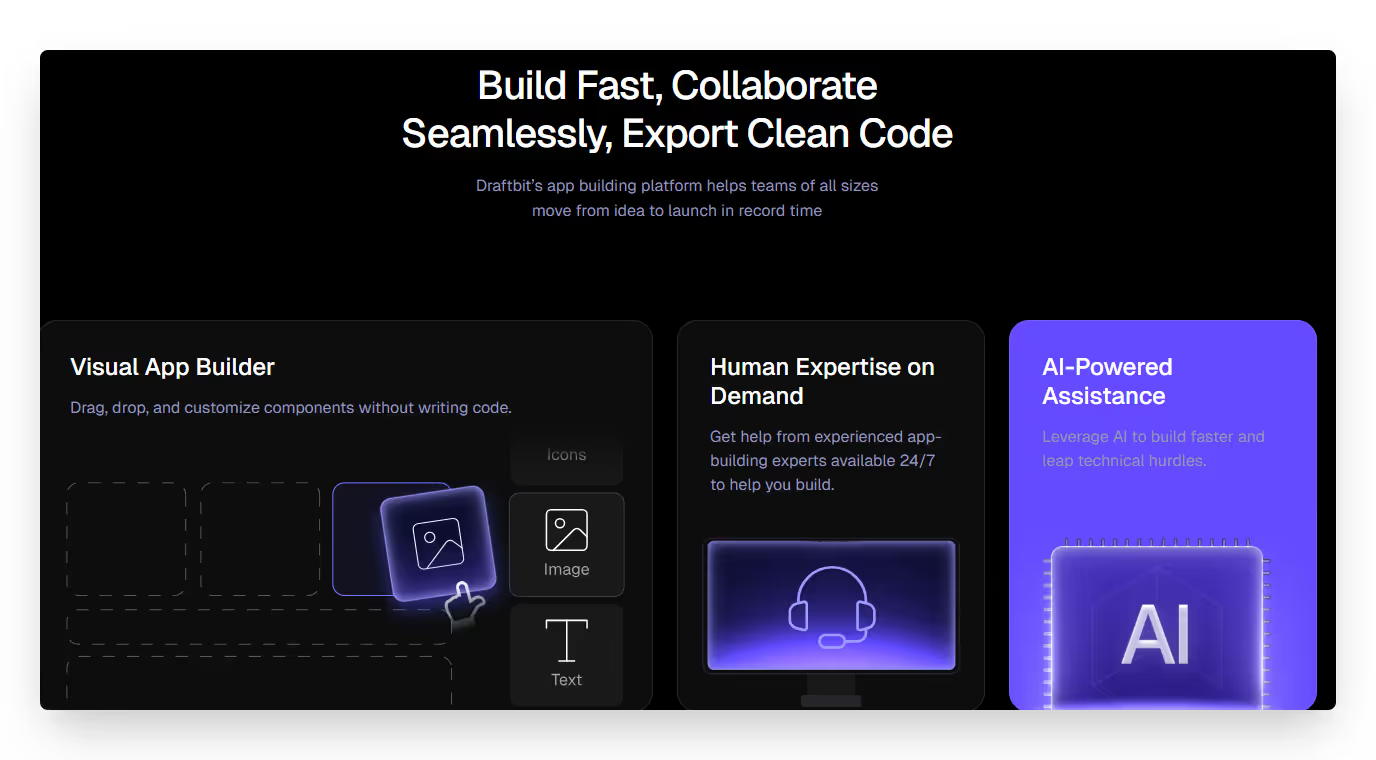
The platform allows for sophisticated custom logic implementation while still providing a user-friendly interface for non-technical team members. This balance makes it suitable for teams with mixed technical capabilities.
Best for: Teams with React Native experience, projects requiring custom logic, applications that may need future custom development, and organizations that want to avoid vendor lock-in through code export capabilities.
Read more | FlutterFlow vs Draftbit
8. Adalo
Adalo combines an intuitive drag-and-drop builder with the ability to create both native mobile apps and progressive web apps from the same project. The built-in database eliminates the need for external data management while providing sufficient functionality for most applications.
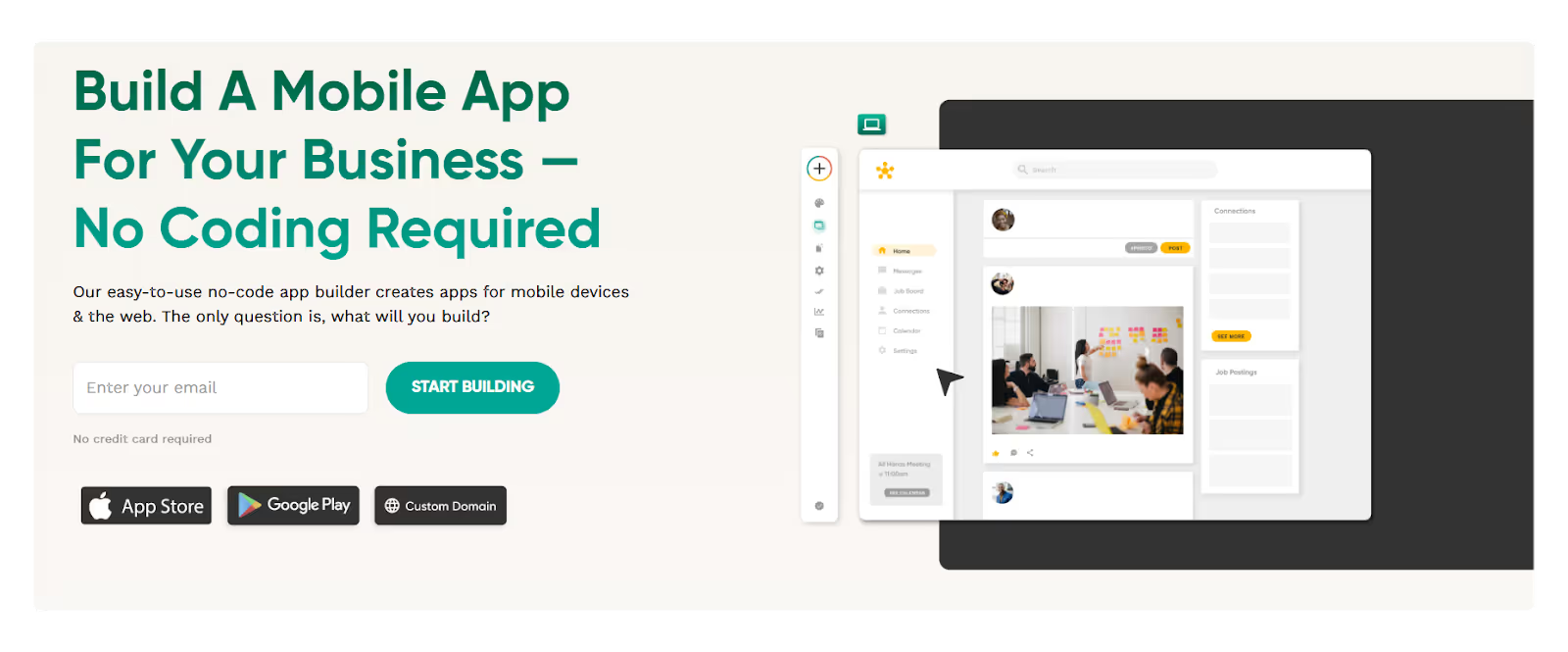
The platform focuses on simplicity without sacrificing essential features, making it accessible to beginners while still powerful enough for production applications. This balance makes it a popular choice for startups and small businesses.
Best for: Startups, small businesses, MVP development, and teams that need both mobile and web versions of their applications. Particularly strong for community apps, marketplaces, and content-driven applications.
Read more | FlutterFlow Security
9. Nowa
Nowa takes a React-based approach to no-code development, appealing to developers who want to leverage modern web technologies while maintaining visual development capabilities. The growing community provides increasing support and resources for users.

The developer-friendly approach means you can implement custom functionality when needed while still benefiting from rapid visual development for standard features. This flexibility appeals to technical teams that want no-code speed with coding flexibility.
Best for: Technical teams, React developers exploring no-code, projects requiring custom functionality, and organizations that want to balance speed with technical flexibility.
Read more | FlutterFlow vs Retool
10. DhiWise
DhiWise supports multiple development frameworks and provides fully exportable code, making it attractive for teams that want to start with no-code but maintain the option to continue with traditional development. The platform's DevOps-friendly approach integrates well with existing development workflows.
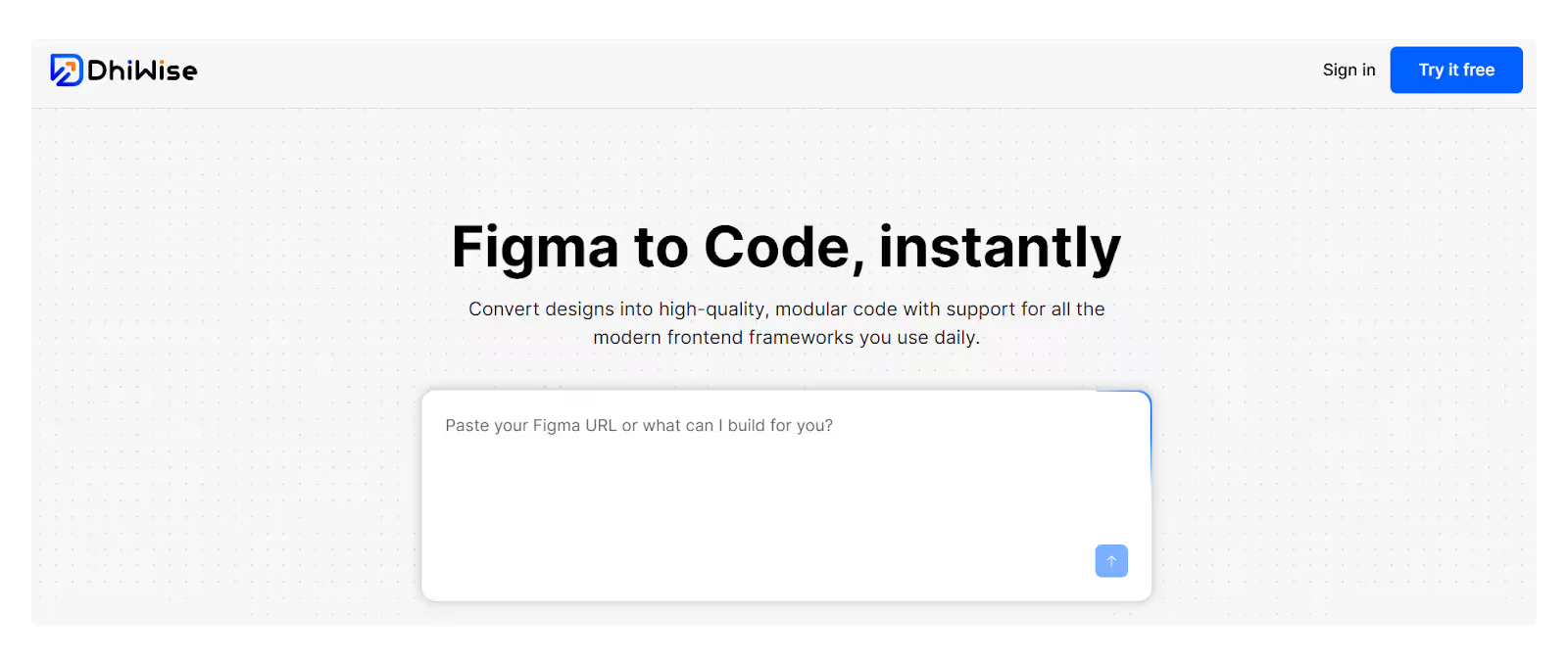
This flexibility makes it suitable for larger organizations that need to maintain development standards while exploring no-code efficiency gains. The ability to export clean, maintainable code ensures projects can scale beyond the platform's limitations.
Best for: Development teams exploring no-code, organizations with existing DevOps processes, projects that may outgrow no-code limitations, and teams that want to maintain code quality standards.
Read more | FlutterFlow vs Wappler
11. Appy Pie
Appy Pie offers a multi-purpose platform that extends beyond mobile apps to include websites, chatbots, and other digital solutions. The comprehensive drag-and-drop interface makes it accessible to users with no technical background while providing enough functionality for diverse project types.

This versatility makes it attractive for small businesses and entrepreneurs who need multiple digital solutions but want to work with a single platform and learning curve.
Best for: Small businesses, entrepreneurs, multi-purpose digital projects, and users who need various types of digital solutions beyond just mobile apps. Good choice for those who want platform familiarity across different project types.
Read more | FlutterFlow vs AppyPie
Comparison Table for FlutterFlow Alternatives
How to Choose the Right FlutterFlow Alternative for You
Choosing the right FlutterFlow alternative depends on your technical skills, app type, and budget. Understanding these three factors will help you find a platform that fits your goals.
- Skill Level
If you’re a beginner, Glide or Adalo offer simple drag-and-drop tools and quick results. For users with some design or tech background, Bubble allows for complex workflows, while Bravo Studio works well with Figma-based designs. Developers who want more control can explore Draftbit or DhiWise, which offer code export and advanced logic features. - Type of App
For MVPs or prototypes, Glide and Adalo prioritize speed. Internal tools work well on AppSheet or Bubble, with strong data and user control. Full-scale apps for stores need platforms like BuildFire or AppGyver, which offer solid deployment and scaling. - Budget
Free plans on Glide or Bubble help test ideas. Long-term, consider pricing based on users and features. A higher-priced tool with better support and faster development may save more time and money overall. Always factor in the total cost of ownership when making your decision.
Final Thoughts
Choosing the right FlutterFlow alternative becomes easier when you align it with your project needs, team skills, and budget. Here’s a quick guide:
- Bubble – Best for complex web apps and workflows
- Glide – Ideal for quick prototypes and data-based apps
- BuildFire – Strong mobile features with app store support
- Bravo Studio – Great for design teams using Figma
- Draftbit – Suitable for developers needing React Native flexibility
- AppGyver and AppSheet – Best for enterprise use cases
- Adalo – Budget-friendly for startups
- AppSheet – Perfect for Google Workspace integration
Test 1–2 platforms using free trials to see how they fit your team and workflow. Building small prototypes helps you find the right balance of speed, features, and ease of use.
Ready to turn your app idea into reality? At LowCode Agency, we've mastered all these platforms and can help you choose the right one for your project. Book a free discovery call with us, and let's discuss which FlutterFlow alternative will deliver the best results for your unique requirements.
Created on
February 25, 2024
. Last updated on
July 16, 2025
.

FAQs
Which is the best FlutterFlow alternative for web apps?
Can I build native apps without FlutterFlow?
What is the easiest FlutterFlow alternative for beginners?
Which FlutterFlow alternative gives full backend control?
Are there cheaper alternatives to FlutterFlow?
What’s the best enterprise alternative to FlutterFlow?







%20(Custom).avif)








